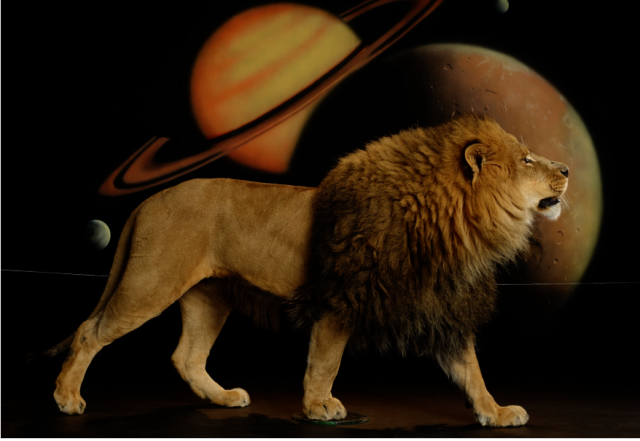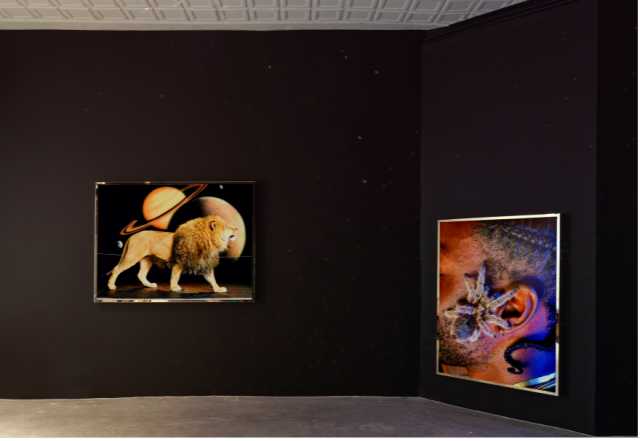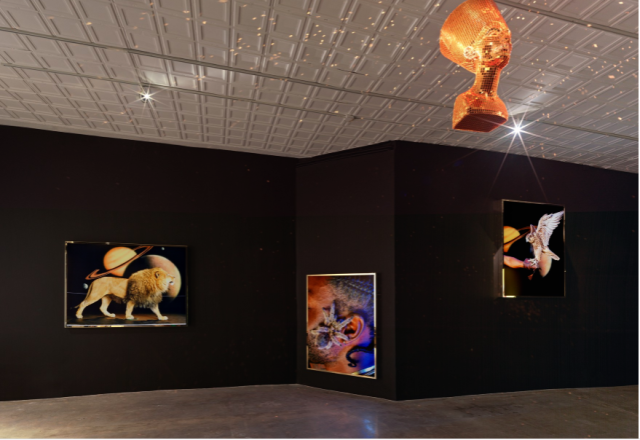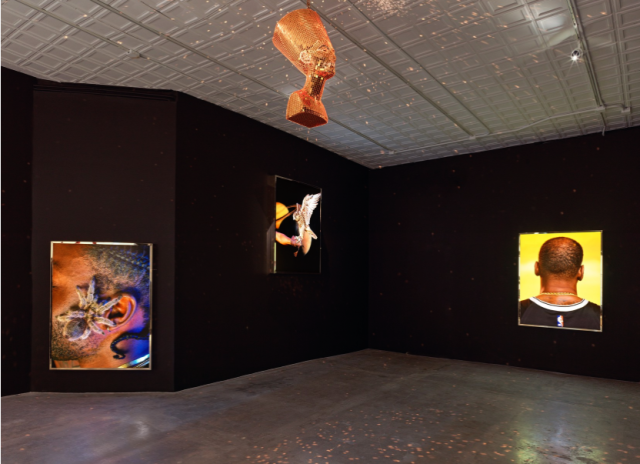 Awol Erizku, Lion (body) I, 2022. This month, the Ethiopian-American artist opened a new solo exhibition at Gagosian gallery in New York City called 'Memories of a Lost Sphinx,' an observation of the ancient mythical figure as a borderless metaphor for "riddles, wisdom and divinity." (Photo: ©Awol Erizku)
Awol Erizku, Lion (body) I, 2022. This month, the Ethiopian-American artist opened a new solo exhibition at Gagosian gallery in New York City called 'Memories of a Lost Sphinx,' an observation of the ancient mythical figure as a borderless metaphor for "riddles, wisdom and divinity." (Photo: ©Awol Erizku)
Awol Erizku Reflects on “Memories of a Lost Sphinx” at Gagosian
Awol Erizku is an Ethiopian-American artist whose work draws on the vast expanse of history to create a counter-narrative to the largely Western discourse on African culture. Last week, the multi-disciplinary artist unveiled a new solo exhibition at Gagosian, titled “Memories of a Lost Sphinx.”
Set against a black-painted interior, a series of six lightbox photographs and an accompanying sculpture ruminates on the fabled sphinx as a complex, cross-cultural symbol that extends between and beyond Ancient Egyptian, Greek, and Asian mythologies. “My first encounter with the Great Sphinx of Giza led me to produce my own interpretation of the mystique and essence of the sphinx as a concept. The result is my interpolation of the space between my memory and imagination,” said the artist.
The constellation of images jumps from lions and falcons floating in the cosmos, a tarantula clamped against a man’s face, to the back of Kevin Durant’s head adjacent to a neighboring hyperrealistic portrait of a snake. Instead of presenting any singular narrative, Erizku uses this grouping to explore issues of identity in regards to the sphinx as a hybrid symbol that embodies riddles, wisdom, divinity, thresholds, and the transition between life and death.
Further bridging the symbols into the present, the Los Angeles-based artist illuminates the space with Nefertiti – Miles Davis (Gold) — a glowing disco ball named after the seminal musician’s 1968 album of the same name. Organized by Antwaun Sargent, “Memories of a Lost Sphinx” is on view at Gagosian New York until April 16, 2022.
—
Press Release
AWOL ERIZKU: Memories of a Lost Sphinx

(Artwork ©Awol Erizku. Photo: Rob McKeever)
My first encounter with the Great Sphinx of Giza led me to produce my own interpretation of the mystique and essence of the sphinx as a concept. The result is my interpolation of the space between my memory and imagination.
—Awol Erizku
Gagosian is pleased to announce Memories of a Lost Sphinx, an exhibition of new works by Awol Erizku. Installed in a black-painted interior, a set of six lightbox photographs accompanied by a mixed-media sculpture represent the sphinx as a complex, cross-cultural symbol that extends between and beyond Ancient Egyptian, Greek, and Asian mythologies. Organized by Antwaun Sargent, this is Erizku’s first exhibition at the gallery.
Erizku works in photography, film, sculpture, painting, and installation, making reference to spirituality, art history, and hip-hop; in the process, he aims to craft a new vernacular that bridges the gap between African and African American visual cultures. Further developing his “Afro-esoteric” iconography in Memories of a Lost Sphinx, Erizku explores the intersections of ancient mythology, diasporic tradition, and contemporary culture.

(Artwork ©Awol Erizku. Photo: Rob McKeever)
The sphinx is a hybrid creature with human and animal attributes: the head of a human, body of a lion, wings of a falcon, and, in some cases, a serpent-headed tail. According to Egyptian tradition, this guardian figure had a male head, whereas in Greek mythology, the sphinx was female and originated in Aethopia. The most notorious Greek sphinx was bested when Oedipus answered her riddle, “What walks on four feet in the morning, two in the afternoon, and three at night?”
Rather than convey any singular entity or narrative, the constellation of images presents allegories of the creature’s attributes, depicting a lion pacing before a cosmic background, a falcon landing on a gloved hand, a tightly coiled snake, and a menacing tarantula. Replacing a pharaoh’s head is a photograph of NBA star Kevin Durant.
The grouping probes issues of meaning and identity while supplanting the body with compositions that explore the conceptual framework of the sphinx as a hybrid symbol that embodies riddles, wisdom, divinity, thresholds, and the transition between life and death. The images are accompanied by Nefertiti – Miles Davis (Gold), a golden mirrored disco ball in the shape of the Egyptian queen’s iconic bust. Titled after Davis’s 1968 album, the sculpture unites visual art with music, known symbols with new forms, and antiquity with postmodernity, while dynamically illuminating the exhibition space.

(Artwork ©Awol Erizku. Photo: Rob McKeever)
Memories of a Lost Sphinx may be viewed within the gallery during operating hours, and at all times through its storefront windows, with the internally lit images and mirrored sculpture transforming the space throughout the day and night. This opportunity for public viewing of Erizku’s work extends the project of New Visions for Iris (2021), a presentation sponsored by the Public Art Fund of his backlit photographs in bus shelters across New York’s five boroughs and throughout Chicago. The lightbox format of these works also relates to the use of the format by Gregory Crewdson, with whom the artist studied while earning his MFA at Yale—while also evoking the way in which the monumental sphinx in Giza is illuminated for tourists.
Awol Erizku was born in 1988 in Gondar, Ethiopia, and lives and works in Los Angeles and New York. Erizku earned a BFA from the Cooper Union for the Advancement of Science and Art, New York, and an MFA from the Yale School of Art, New Haven, CT. Collections include FLAG Art Foundation, New York, and the Museum of Fine Arts, Boston. Exhibitions include New Flower | Images of the Reclining Venus, FLAG Art Foundation, New York (2015); Mystic Parallax, FLAG Art Foundation, New York (2020); and New Visions for Iris, Public Art Fund, various sites in New York and Chicago (2021). His photographs of cultural and creative leaders have been featured in the New Yorker, New York, GQ, and Vanity Fair.
—
If You Go:
AWOL ERIZKU
Memories of a Lost Sphinx
March 10–April 16, 2022
Gagosian Gallery
Park & 75, New York
More info at www.gagosian.com.
Join the conversation on Twitter and Facebook.

























